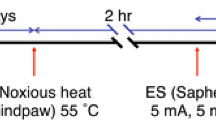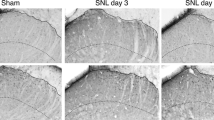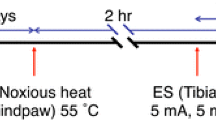Abstract
c-Fos expression was studied in the lumbar and sacral spinal cord regions involved in processing afferent input from the lower urinary tract and a comparison was made between spinal cord-injured (SCI) animals and control animals with intact neuraxes. Afferent pathways from the lower urinary tract were activated either by insertion of a catheter through the urethra into the urinary bladder or by catheterisation plus induction of reflex micturition contractions by intravesical saline infusion. Placement of a catheter alone elicited Fos expression in a similar number of neurones in SCI and control rats mainly in the medial dorsal horn (MDH) and dorsal commissure (DCM) in the segments L1–2 and L5–S1 with a maximum in L5. Additional saline infusion induced low-frequency, high-amplitude, rhythmic bladder contractions of long duration in the rats with intact spinal cords, whereas in SCI rats, bladder distension elicited reflex contractions at a higher frequency, smaller amplitude and shorter duration. However, the basal and mean bladder pressure, as well as the total contraction time relative to the whole recording time, was not significantly different. Distension-induced bladder contractions markedly increased Fos expression primarily in the spinal segments L5–S1 in the control rats, where the majority of bladder and urethral afferent fibres terminates. Fos-positive cells were located in the MDH, lateral dorsal horn (LDH), DCM and the lateral aspect of laminae V–VII. Compared to controls, Fos expression after spinal cord injury (SCI) occurred in a significantly greater number of neurones throughout the segments L3–S1 following induction of bladder reflexes. The greatest proportional increase in the number of Fos-positive cells occurred in L3–5 which normally receive only little afferent input from the urinary bladder. Cell numbers predominantly increased in the LDH and lateral lamina V–VII. The data are consistent with the concept of a neuroplastic reorganisation of spinal pathways after SCI. Unmasking of silent synapses or formation of new connections by afferent axonal sprouting caudal to the lesion, as evident from the increased numbers of cells expressing Fos after bladder distension, could be factors underlying the emergence of reflexogenic micturition in chronic SCI rats.
Similar content being viewed by others
Author information
Authors and Affiliations
Additional information
Accepted: 27 May 1999
Rights and permissions
About this article
Cite this article
Callsen-Cencic, P., Mense, S. Increased spinal expression of c-Fos following stimulation of the lower urinary tract in chronic spinal cord-injured rats. Histochemistry 112, 63–72 (1999). https://doi.org/10.1007/s004180050392
Issue Date:
DOI: https://doi.org/10.1007/s004180050392




